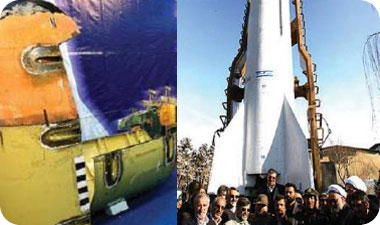Twenty years after Israel, Iran succeeded for the first time in launching a small satellite, to prove its capability, on top of a missile of its own production, which, according to Major General Uzi Rubin, is more dangerous than a photography satellite

Universe Today website It is reported that Iran launched its first functioning satellite into space on Monday night using a long-range launcher adapted for launching into space. This is a research and communication satellite. Iran joins a small group of countries capable of building and launching their own satellites.
In 2005, Iran used a Russian rocket to launch a satellite, andIn August 2008, Iran reported the launch of a satellite into space using the Sapphire 2 rocket, but other sources said that the rocket suffered a serious malfunction that caused the launch to fail.
This week's launch was the first successful launch of their rocket and the first functioning satellite launched from Iranian soil. The launch took place in the middle of ten-day celebrations to mark the thirtieth anniversary of the Iranian Islamic Revolution. The president of Iran, Mahmoud Ahmadinejad, said on Iranian television that the satellite was "a step forward towards justice and peace".
The small satellite, Umid which means hope in Persian, carried experimental control systems, communication equipment and a small payload for remote sensing. A US military tracking station that monitored the launch said that the two objects, probably the satellite itself and part of the accelerator, circle the Earth in an elliptical orbit whose low point is 245 kilometers high and the high point is 437 kilometers high. Its lap angle is 55.5 degrees.
In doing so, Iran joins the ranks of only eight countries capable of launching satellites after the Soviet Union (now Russia) which launched Sputnik 1 in 1957, the United States which launched Explorer 1 in January 1958, and then France, Japan, China, and the United Kingdom (which was content with a single launch ), India and Israel developed and succeeded in launching satellites using launchers made by them. Iran plans to launch several satellites in the coming years, according to it to monitor natural disasters and defend against them and to serve the media within the country. Iran is under UN sanctions because some Western powers believe it is trying to build an atomic bomb. Tehran says that its nuclear ambitions are limited to energy production and that the satellite project is entirely for peaceful purposes.
Uzi Rubin, who was in charge of the Arrow project, interviewed Kirschenbaum for the London show on Channel 10 this evening and said that the Iranians who received the technology from North Korea surpassed their teachers who did not launch satellites themselves. According to him, it is a satellite and a launcher that do not have much significance. "The launcher can't do much, 20-30 kilograms. However, the whole process allowed them to learn about the whole issue of launching in stages.
"The Iranians announced a space program already in 1998, they work with full transparency. It took them 10-11 years which is a lot of time, apparently they didn't allocate enough money. In August 2008 there was an unsuccessful attempt. Yesterday evening they launched and all their people spoke the same language, which indicates that they probably succeeded."
In response to Yaron London and Moti Kirschenbaum's question about how long it would take the Iranians to develop a spy satellite, he said that it would be five years and maybe more until the Iranians could launch a spy satellite. "However, we are exposed to the Iranians, the Hamas right now, open Google Earth. Israel is photographed from the right and left. What's special is that when you have the spy satellite, you don't order photos from anyone, no one knows exactly what you're filming. In any case, this is strategic intelligence, not tactical intelligence. They have roadmap And we intend to reach in 2015 the ability to launch observation satellites like Ofek.
Rubin also confirms that those who can launch a satellite into orbit can arrive with a similar missile anywhere in the world and this means that they have the ability to develop ballistic missiles.

4 תגובות
I wonder how advanced ground-to-space missile technology is...
Let them work for someone else, peace is the last goal they want to achieve!
What peace goals and what shoes, this satellite must be taken down as soon as possible
Congratulations